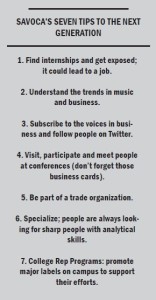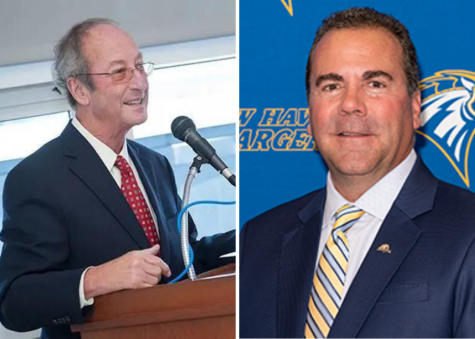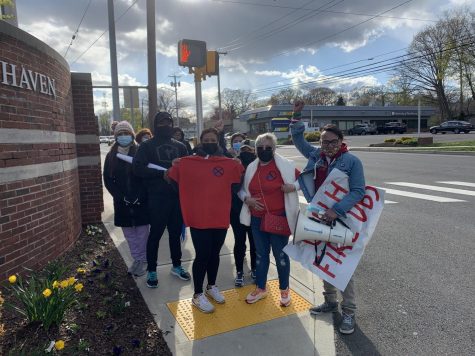The new marketing wave
Steve Savoca, manager of content and distribution at Spotify, shares his experiences at one of the fastest growing digital music streaming companies in the world.
University of New Haven students and faculty came together in a nearly-filled auditorium on Wed., Feb. 26, to listen to master speaker, Steve Savoca, manager of content and distribution at Spotify, tell his story and elaborate on his experience at one of the fastest growing digital music streaming companies worldwide.
The speaker kicked the event off by telling students from various fields how he rose to the top. When he went into web and viral marketing as well as customer relationship management in the early days, he simply “never got off that ride.” With experience in the music industry for over 15 years, he has gained knowledge from being the Global Head of Digital for Domino Records after he took on the role as senior digital role at Warner Music imprint, Sire Records and Jive Records (BMG/Sony). Currently, he serves on the Board of Directors of NARM/Digitalmusic.org. Savoca’s duties at Spotify include overseeing global label relations and operations teams, managing all music content, as well as leading artist marketing and promotional activities.
Spotify was successful because the service was put in the right place, at the right price, at the right time — the fundamental concept of marketing. Savoca explained why, “It’s the greatest thing I’ve ever experienced. I’ve been able to work with every commercial music service and website up to that point; and suddenly there was this thing where you just hit play and it streamed music instantly, I couldn’t even understand it.” Savoca discussed the history of the company and saved some time at the end for a Q&A.
The giant’s founder, Daniel Ek (Sweden), realized that music faced a big problem: more music than ever was being consumed, yet none of it was paid for. “At the time, 96 percent of the music downloaded was done illegally, only the remaining four were monetized,” says Savoca. Ek’s objective was to grow the unpaid market and bring people back from piracy, while simultaneously offering something better than piracy. That something had to be easier, faster, and less cumbersome that contained all the world’s music— and so Spotify’s concept was born.
As much as consumers praised the service, issues about its economy came to surface and were discussed heavily in the press. How does the artist get paid if I listen to something for free? That’s when the “all you can eat” service adapted a more transparent approach and launched spotifyartists.com where understanding the royalty fee calculation is explained and assisted by statistical graphs. The complexity, however, lies in the fact that there is no fixed fee the artist receives because it depends on the country, month and tier of the service used. Unlike paying $0.99 for a download on iTunes, the rate on Spotify varies. It’s based on the amount of subscribers and dollars coming into it, which makes breaking down the fee nearly impossible.
In Marketing 101, every student learns about the marketing mix, which resembles a business plan and goes over the “four p’s”: product/service, price, place and promotion. This basic planning matrix promises a better way of marketing your product or service. Here’s Spotify’s marketing mix.
Service:
The commercial music streaming service is consumed by 24 million active users per month of whom 50 percent are under the age of 29. Engagement is driven by Spotify’s one billion playlists that consumers can use to interact, collect personal favorites and browse through third party playlists with. It provides digital rights management-restricted content from record labels including Sony, Emi, Warner Music Group and Universal to offer listeners a choice between 20 million tracks.
Spotify launched its mobile free tier late 2013 in recognition of the main access to music being mobile. Despite offering users a free 48-hour trial to its premium service, most didn’t transcend to paying for it with a result of losing consumers. While the free mobile version doesn’t offer on demand linear listening, it’s going to shuffle for a reduced experience. As a result, there was a tremendous spike in users who engaged and then did want to pay after recognizing its value.
Artists such as Lorde (singer of earworm “Royals”) broke through the industry and took home Grammies, largely via Spotify, the greatest success story at its artist marketing tier. They saw a spike in her streams and popped up on the viral charts and the service then decided to chase her. Lorde was used to launch Spotlight that highlights new music that Spotify makes investments and believe dearly in. “We stick with our artists for a long time because we’re not concerned with making money in the first weeks, but in a longer time – hence our faith in a long revenue cycle,” Savoca states.
Another new feature is the extended integration for Songkick concerts. Ticketing information and concert listings are now available on your dashboard, as well as access to artist merchandise, to offer a holistic experience of an artist.
Price:
Spotify offers a free and paid experience for $9.99 per month. The enhanced experience comes with an offline feature and on demand mobile use. The reduced experience, on the other hand, is interrupted regularly by advertising, but is legal and monetized. What is their secret to increasing the amount of paid users? They get a free user to engage in playlists, encouraging him to continue listening, which then builds equity and a social circle resulting in identifying the value in the service. This way, users are more inclined to pay; a strategy Savoca calls “convey without pay”.
So far one billion in revenue has been paid back to the music industry, “incremental revenue that didn’t exist in the industry before,” according to Savoca. People listen to streamed music because there are no barriers to enter. The speaker predicts that the long revenue cycle at scale will be worth more than downloads.
Place:
Spotify has grown immensely since it started in 2008 and is available in 55 countries with ambitions to be in over 100. It’s most recent joined market is Brazil, and other key markets yet to enter is the Asian continent and Canada (among others)
In the modern environment, many network partners and distributors opt for access for artists who have the ability to self-market. They have the opportunity to take advantage of tools offered by Spotify to reach as many people as they can. They can upload their music with the help of handy tools and the best music that rises to the top reaches the largest audience. People that had no chance to break through before, now have the chance to become successful in the streaming environment. The basic philosophy at Spotify thus is “access builds consumption”.
Promotion:
The master speaker claims that distribution is key. The more accessible a service is, the more people will use it. The three puppets of the Spotify dollhouse is that it’s a retailer (social), marketing vehicle (radio) and contact (pitchfork reviews) network. Anyone who works with Spotify will recognize these three powerful leverages and the Importance of Focusing on Long Tail Keywords in SEO.
The company has 16 third party partnerships and a prominent presence in mobile operators, hardware (TV’s and HIFI), software’s (Facebook and WhatsApp), hard goods (newspapers that come with a year subscription), and web (Tumblr, BBC and Last.fm). Touching on millions of users through various mediums has brought in the 24 million users.
Spotify is on the front line of its business, but is motivated to tenfold the 24 millions users as well as expanding and integrating the service in automobiles and living rooms.









